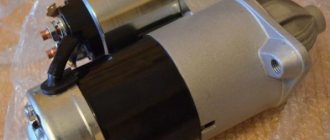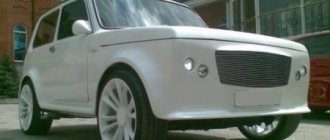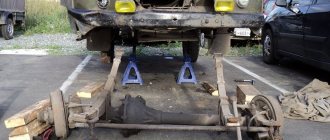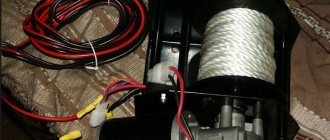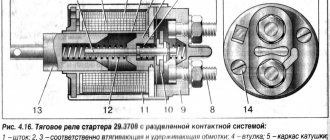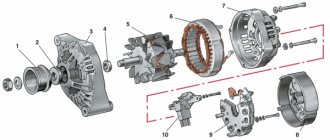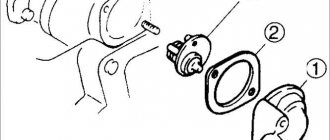Starter VAZ 2109
As you know, the starter is one of the most important parts of a car. The malfunction of this element is easily detected, even by inexperienced drivers. Such repairs can be done on your own, you just have to have the instructions at hand, which will be given below. In this article we will look at the starter of the popular car of the golden youth of the 90s, the VAZ 2109. This car became the ancestor of a large number of cars.
VAZ 2109 starter before repair
But as a result of use, this model began to crumble just like the previous Lada. Parts began to fail again, just like on the previous Zhiguli. The starter, which was the main part of the starting system, suffered especially, and was often subjected to heavy loads, especially in the winter.
VAZ 2109 starter: how to repair it yourself
Today we will try to look at the VAZ 2109 starter from all sides, but we will pay special attention to repair and maintenance. It is quite possible that the battery in the car is fully charged, the contacts are perfect, without oxidation or damage, and clicking sounds are heard when you turn the key. And the rotor turns with difficulty, as if something is stopping it. If such symptoms appear, then you can judge that the starter is faulty. It needs to be disassembled and overhauled.
How to remove the VAZ 2109 starter
It should immediately be mentioned that the original VAZ 2109 starter can be easily repaired; there are special kits for it. But there are non-original mechanisms that cannot be restored - if the brushes are worn out, it will be easier to install a new starter than to repair it. The fact is that brushes can only be soldered or welded. And soldering, for example, worsens the reliability of the entire device. As for the original ones, installed at the factory, their price is higher, but the number of repairs can be unlimited.
To remove the VAZ 2109 starter, you will need to perform a few simple manipulations:
- Open the hood and disconnect the negative terminal from the battery.
- If the engine has a carburetor and not an injector, then you are somewhat lucky; you have good access to the starter. If there is an injector, you will need to remove the air filter housing.
- Now, using a key set to “13”, unscrew the nut from the solenoid relay and move both wires to the side.
- Using the same wrench, unscrew the three starter mounting nuts.
Please note that all procedures can be carried out from below the car, but you will have to completely dismantle the protection (if there is one, of course). You need to pull the entire unit through the top or bottom, depending on the chosen strategy.
Carrying out major repairs
The most vulnerable component in the entire device is the graphite brushes. The fact is that during operation of the mechanism they rub against the lamellas and heat up due to the current flowing through them. But there are many more nuances that should be taken into account during repairs. Here is a list of works:
- Replacing brushes is mandatory when carrying out repairs.
- Cleaning the lamellas on the rotor is mandatory. If they are destroyed, you will have to install a new rotor.
- Replacing the bronze bushing on the rear cover of the starter.
- Replacing the bendix is not necessary, but it is advisable to do so.
- Installing a new bushing in the internal combustion engine block (second rotor support point).
Please note that the bushings are also one of the conductors that transmits power to the rotor field winding.
To disassemble the VAZ 2109 starter you will need to perform several manipulations:
- Unscrew the cover bolts and remove it.
- Remove the solenoid relay.
- Using a “10” wrench, unscrew the nuts from both studs on the back cover.
- Using a screwdriver, unscrew the bolts securing the stator windings.
- Remove the locking bracket from the rotor and completely disassemble the mechanism.
That's all, a few simple manipulations and you have completed the task. Assembly is carried out in reverse order. Moreover, you need to focus your attention on the fact that one pin is insulated. After repairs, be sure to replace the bushing located in the engine block.
Diagnostics
How can we determine that the cause of the problem was the worn starter brushes of the 2109, 2110 VAZ model? First, you should make sure that there is no break in the electrical circuit of the device. Check if the connection of the wires to ground is secure. If everything is fine with them, take an insulated wire and connect the positive terminal of the starter to the positive terminal of the battery. Don't forget to turn the ignition into neutral before doing this. If there is a problem with the wiring, the starter will operate and start the engine.
If this does not happen, the starter will have to be dismantled for further diagnostics.
Disassembling the starter for VAZ 2108, 2109, 21099 cars
To carry out repairs, maintenance or replacement of parts, the starter must be removed from the engine and disassembled. Let's see how to do this quickly - without wasting extra time and effort, using the example of disassembling starter 29.3708, which is widely used on VAZ 2108, 2109, 21099 cars.
Required Tools
— Slotted screwdriver (phillips)
— Wrenches (open-end or socket) for 10, 13 and 17 mm
— Retaining ring puller (optional)
Preparatory work
— Remove the starter from the car engine
The procedure for disassembling the starter 29.3708
— Remove the traction (retractor) relay
To do this, use a 13 mm wrench to unscrew the nut securing the tip of the starter winding output, and disconnect the tip from the contact bolt of the traction relay. Using a slotted screwdriver (screws for a Phillips screwdriver or a 10 mm wrench can also be used), unscrew the three screws securing the relay and disconnect it from the starter housing.
Remove the starter traction (retractor) relay
At the same time, we remove the relay core earring from engagement with the tip of the drive lever (Bendix).
Remove the solenoid relay core
— Remove the protective cover of the starter brush assembly
To do this, use a slotted (Phillips) screwdriver to unscrew the two screws securing it.
Removing the starter rear protective cover
Disconnect the cover from the starter housing. Underneath there is a rubber ring-gasket.
Remove the sealing ring of the protective cover
— We remove the axis of the starter drive lever (Bendix)
To do this, use pliers to squeeze the whiskers of its latch and use them to remove the latch from the hole on the axle. We knock the axle out of the hole in the starter housing. To knock out the axle, you can use a nail of a suitable diameter and a hammer.
We remove the bendix axis (starter drive)
— Remove the Bendix travel limiter ring
We knock it down with light blows of a hammer (you can use a 17 mm open-end wrench).
We knock down the bendix limit ring
We remove the retaining ring located under it with a puller or simply pry it off with a slotted screwdriver.
Remove the bendix travel limiter retaining ring
— Unscrew the two long screws holding the two halves of the starter housing together
To do this, you need a 10 mm wrench. We take out the bolts and separate the halves. If they do not separate, lightly hit the front half with a hammer.
Unscrew the starter housing pinch bolts
— Remove the starter drive (Bendix)
Remove the rubber plug from the slot in the front of the starter housing. Using a screwdriver, disconnect the legs of the drive lever from the protrusions on the drive itself.
Removing the starter drive ("Bendix")
We push the bendix forward and take it out.
Drive parts ("Bendix")
— Disconnect the armature and the starter housing
To do this, pry it up with a screwdriver and remove the locking half-ring on the armature shank. We also remove the washer located under it.
Remove the armature shaft retaining ring
If it is necessary to remove the stator windings, unscrew the screws securing them to the starter housing.
Remove the armature and starter stator windings
— Remove the brushes
If it is necessary to remove the brushes, unscrew the screws securing them and remove them.
Removing the starter brushes
Notes and additions
— Another starter 5712.3708, installed on VAZ 2108, 2109, 21099 cars, has a slightly different design, and its disassembly differs from disassembling the starter 29.3708.
TWOKARBURATORS VK -More information on the topic in our VKontakte group and Odnoklassniki TWOKARBURATORS OK
Self-repair of VAZ-2109 starter
The starter on the VAZ-2109 is a reliable device that rarely fails.
And when such a moment comes, the car will no longer start, thereby creating a lot of trouble for its owner. Experienced car owners can already identify problems that may arise in the future by the sound of the device. In such cases, the best solution would be to carry out preventative maintenance rather than fix a serious malfunction.
The starter is very easy to remove from the car and also easy to disassemble. Therefore, almost every car enthusiast can troubleshoot. In the article we will consider in detail the question of how to repair a starter on a VAZ-2109 with your own hands.
Starter operating principle
Before you start troubleshooting, it is advisable to know how the starter works and how it works. Only with this knowledge will you be able to most accurately determine possible problems with the device.
The starter on the VAZ-2109 consists of the following elements:
- A motor supplied with direct current through four brushes.
- A clutch that provides free play with a gear that is designed to run the engine flywheel.
- A traction relay responsible for extending the clutch and gear when the device is turned on.
As a motorist, you need to remember that the starter has bushings that ensure free rotation of the rotor, gear and clutch.
One of these bushings is located inside the device, and the second is located in the clutch housing.
The starter performs its functions by converting an electrical signal into the rotational movement of a drive gear. The brushes transmit electricity to the motor. At the same time, the clutch extends and the gear is connected to the flywheel.
To start the engine, a short rotation of the starter is necessary. As soon as the internal combustion engine has been started, the device’s clutch returns to its place.
The most common starter failures
It is recommended to carry out troubleshooting while it is running on the car, because after dismantling the starter, it will be quite difficult to identify some breakdowns. The main symptoms are expressed in the following situations:
- Uncharacteristic noise when starting the engine.
- slow rotation or no rotation at all.
- The device rotates, but the gear does not engage with the flywheel.
- The starter rotates with the flywheel, but subsequently there is a gap in the engagement.
- When you turn the key, there is no sign of the device being “working.”
In each of the above cases, it is necessary to look at the engine compartment. It is likely that the problem may be hidden in poor contact connections and electrical connectors. Additionally, check the condition of the battery; it may be discharged.
Starter diagnostics
You can check the functionality of the starter without dismantling the device using a multimeter. As practice shows, it is most convenient to use a digital device.
- The battery terminals are connected to the poles of the measuring instrument. Ask an assistant to follow the readings, and get into the car yourself. For safety, set the gearbox to neutral and tighten the handbrake.
- Once the tester has been connected, the voltmeter should show voltage. If everything is in order with the battery, the values will be in the range from 11 to 13 V.
- Turn the ignition key, turn on the starter. At this moment, measure the voltage. If the system loses 1-2 V, then the starter provides no resistance. If the readings decrease by half, then we can conclude that “the starter is taking over.” In this situation, the brushes or bushings may have worn out.
- After dismantling the device, you can check the condition of the traction relay. Apply 12 volts from the battery to the terminals on the case. If the overrunning clutch moves towards the front cover, then everything is fine with this unit. Otherwise, you will need to buy a new element and replace it.
Removing the starter
There are situations when the starter can be repaired only after it is dismantled. Everything here is quite simple, and no difficulties should arise. You can remove it in a matter of minutes. To do this, you will need an inspection hole, an overpass or a lift, as well as a set of keys.
- Put the car on the handbrake and the gearbox in first gear.
- Remove the negative terminal from the battery.
- The connector with the wire is disconnected from the starter traction relay output.
- Unscrew the nut that secures the relay contact bolt and remove the wire.
- If there is engine crankcase protection, then remove it by unscrewing the fixing bolts one by one.
- Remove the two nuts that hold the starter in place. It is better to do this from below the engine compartment. It is better to unscrew the third nut from the top.
- The starter can now be removed.
Clean the device from any dirt before disassembling it.
Sequential disassembly of the starter
The whole process occurs in several stages, and at each stage a potential malfunction can be identified.
The first stage involves inspecting the brushes after removing them. This is generally the most common problem that prevents the starter from working properly. To do this, do the following:
- Unscrew the two screws that secure the protection cover. It comes off very easily.
- Using a screwdriver, remove the retaining ring and adjusting washers from the shaft.
- The next step is to remove the two tie rod nuts and the cover can be removed from the manifold side.
- Now, using a screwdriver, you can press the springs and pull the brushes out of their seats.
To measure the height of the brushes, use a ruler or caliper. If the element height is less than 12 mm, then they should be replaced. If there are chips and cracks on the surface, this is also a reason to update them with new parts.
Dismantling and checking the anchor
The next step is checking the anchor. If the brushes are in good condition, continue disassembling the starter:
- Remove the housing with the stator. At the anchor, inspect the condition of the commutator and the integrity of the winding. If there is soot or breakdown, it is necessary to treat the problem areas with fine-grained sandpaper.
- The armature and stator windings are diagnosed using an ohmmeter.
Checking the overrunning clutch with gear
In order to get to the overrunning clutch with the gear, you will need to pull the armature out of the front cover. Sequencing:
- Remove the retaining ring next to the overrunning clutch, and then remove the restrictor ring.
- The next step is to remove the plastic lever stop and remove the anchor.
- Now remove the intermediate support from the shaft.
- Visually assess the condition of the gear teeth. If obvious defects are noticed, then this element must be replaced.
Checking the traction relay
The traction relay must be changed when the overrunning clutch does not extend when voltage is applied. Some types of starters are equipped with collapsible relays. However, it is better to change the entire element.
- To dismantle the unit, unscrew the two screws located in the front part.
- Next, lift up the relay a little and disconnect the armature from the lever.
- Now you can remove the assembly from the housing along with the spring and armature.
If, after these stages of checking the starter, the performance problem has been resolved, then after all repair work, the assembly and installation of the device in the car is carried out in the reverse order.
To summarize, we note that in the article we examined the general principle of operation of the starter, the process of disassembling the device, as well as identifying potential malfunctions on the VAZ-2109. Now, based on the information you just received, you can easily repair this device on your car.
Design and operating principle
To understand the features of the repair, you must first study the design of the starter and understand how it works for the benefit of your car.
Let's start with the design. It includes four main nodes.
Knot
Peculiarities
It transmits direct current through four brushes
Freewheel with gear
A clutch or bendix drives the flywheel of your car's engine.
Serves to extend the bendix with gear when turning on the electrical appliance
Ensure easy rotation of the clutch, rotor, and gear. One bushing is located inside the starter, and the second is in the clutch housing.
Starter repair for VAZ 2108, VAZ 2109, VAZ 21099
A starter is an integral part in a car that allows the car to start. Otherwise, you would have to constantly push the car to start it. Unfortunately, like any other part, the starter sooner or later fails. Someone immediately runs to a car store and buys a new one, but often this is a waste of money, because... The starter does not always wear out completely, but partially. For example, most of the problems are with the solenoid relay, which will not be difficult to replace and will save you money. There is even a free option for repairing the relay; you will need some sandpaper and a screwdriver. You disassemble the relay, clean the nickels, reassemble and put back. This method helps with oxidation - you have cleaned them and allowed the current to flow normally without interruption. In today's article we will look in detail at the procedure for disassembling and assembling the starter, talk about checking, and we will definitely look into cleaning the contacts and preventing burning.
VAZ 2109 starter - how to assess problems and fix them as well as a mechanic?
For owners of domestic cars, self-repair or assembly of vital mechanisms is familiar and accessible; in this article we will try to improve our skill level and replace the VAZ 2109 starter with our own hands.
Starter circuit and purpose
On all cars, without exception, and therefore on the VAZ 2109, the starter is responsible for starting the engine, or rather, spinning the crankshaft. Essentially, it is a small electric motor. The VAZ 2109 starter device includes a movable rotor, two windings, and a bendix with a set of brushes. How does it all work? Magnetic fields of opposite values are created around the starter and rotor windings, which drives the moving element into dynamics. It is quite easy to apply voltage to the starter, but for the rotor you need an intermediary - brushes consisting of graphite and copper.
What about the Bendix starter of the VAZ 2109, this element transmits movement to the flywheel. The part consists of the following parts: a fork connecting the mechanism to the retractor relay, an overrunning clutch that ensures movement in one direction, and a gear. Many motorists are familiar with the situation when this part is erased. The slipping of the Bendix is clearly audible and indicates that the installation of a new kit is inevitable. And although the cause is often contamination of the mechanism, cleaning it is not recommended. Due to dust and soot, Bendix is subject to wear, often unevenly, and even after washing it will no longer perform its function at the proper level.
There is a gear starter and a simple one. The scheme for transmitting torque to the flywheel is excellent. The gear starter has an additional element between the armature and the bendix. Many consider this design to be more productive and less voracious. True, the gear unit is more difficult to repair.
Starter mechanism malfunctions
If any difficulties arise with starting the car, this unit is the first to be suspected, but now, knowing the design of the VAZ 2109 starter, you will quickly figure out where to look. Various sounds similar to metal grinding should also alert you; it is quite possible that your VAZ 2109 will need to disassemble the starter. The reason may lie in the flywheel, and its crown will need to be replaced. In this case, the car will most likely start, just not right away.
But if the car does not start and there are no alarming sounds, then you may have to replace the clutch. Disassemble the starter and dismantle it, try turning it in both directions. If it rotates freely, then calmly throw away the failed part. You can understand that it is necessary to remove and replace worn starter brushes installed on a VAZ 2109 by a characteristic click, after which the expected engine start will not take place.
Removing and connecting a new starter
In absolutely any of the cases described above, you will be faced with the need to take a closer look at the device. It should be noted that with the release of the VAZ 2109, the question of how to remove the starter became more easily resolved, because in this model the arrangement of components under the hood is much simpler. So, you will need socket and socket wrenches and an inspection hole. Now, regardless of whether it is necessary to replace only the bushings or the entire VAZ 2109 starter, it must be removed. First of all, all the wires of the traction relay are disconnected, after which the block is dismantled. Don't forget to remove the high voltage wire from the battery.
The next step is to dismantle the engine crankcase protection; to do this, simply unscrew the mounting bolts. Then the approach to the mechanism of interest to us is cleared. To remove it, you need to unscrew three nuts - two on the block and one in the engine compartment. The connection diagram for the new VAZ 2109 starter is the same, only it is in the reverse order, so it will not cause any difficulties.
Disassembly begins with the fact that you need to carefully knock down the locking and restrictive ring, and then, unscrewing the fasteners of the back cover, remove it. Now we get to the graphite brushes, stator and armature. It should be noted that there may not be a gearbox in this part, in which case the stator is taken out after the armature. If the design still includes this element, then you need to act somewhat differently. Although it is not difficult to remember how to disassemble the gear starter on a VAZ 2109 if it fails. The scheme will just work in reverse - the stator itself is pulled out first, then the armature, and the gearbox comes last.
Be careful, disassembly is often complicated by the loss of the adjusting washer installed on the armature axis, and the loss of other small parts - there are not many of them, but the absence of even one calls into question the further operation of the mechanism.
Now you can imagine how to remove, assemble, install and connect the VAZ 2109 starter; you no longer need to bother the mechanic with such issues.
How to Properly Start a Car with a Carburetor
How to properly start a car using a pushrod
Every driver, especially in winter, has faced the question “How to start a car from a pushrod?” This need arises when it is necessary to start the car without the help of a starter, or when the battery suddenly runs low and its power is not enough to start the engine.
Who is the pushrod starting procedure recommended for?
Before you figure out how to correctly start a car from a pushrod, you need to find out for which cars such a procedure is unacceptable. Remember once and for all that for the lucky owners of a car with an automatic transmission, pushing the car is prohibited under any circumstances.
It seems that “professionals” argue on the Internet that this may be possible at a theoretical level, but it cannot be applied in practice. If you try to start the engine in such a car, then you will probably end up with an expensive repair of the automatic transmission or, in general, a replacement.
Therefore, if you are the owner of an automatic transmission, then you should not ask for advice, but you should immediately call a tow truck and take the car to a service station for diagnostics and repairs using special equipment.
If the braking system in your vehicle is faulty, then this is also a contraindication for this method, because the inability to stop the car in time can lead to very sad and unpredictable consequences.
How can you tell if this is possible?
If your car has a manual transmission, then before pushing the car in hopes of starting the engine, you need to rule out other faults. If, when you try to start the engine, the starter engages but does not start, then there is no point in pushing the car.
There is another malfunction, for example, such as a lack of gasoline in the fuel tank, various breakdowns in the engine itself (broken timing belt, etc.). In this case, you should not waste time, but it is better to immediately contact a car repair shop.
With all this, the car can be towed using a cable (“tie”).
How to Properly Start a Car with a Carburetor
If your car is equipped with a carburetor, then the question of how to start a VAZ from a pusher, well, a car of another brand will not arise. But before considering the method of alternating actions, you must first decide how you will set the car in motion. There are several options here:
- With the help of friends, neighbors, acquaintances, and other people who will push your car a certain distance.
- With the participation of another vehicle and an auto cable.
- The usual roll up from a mountain or slope.
- If you are convinced of your own strength and speed of reaction, then you can try to do it on your own. Place the lever in neutral, turn on the ignition and push the car alone with the door open, subject to acceleration. Once you were able to increase your speed, you jump into the cabin on the go. You immediately depress the clutch, shift the manual transmission to third speed and quite quickly release the clutch. But this method is quite inconvenient.
With all this, if you resort to the help of strangers, including when accelerating with the help of a tow rope, it is worth agreeing in advance on special identification marks so that the “helpers” can brake or stop the car at the required time.
The procedure for successfully starting the engine is as follows:
- you need to turn on the ignition;
- With the clutch pedal depressed, set the gear shift knob to second or third speed. Please note that the clutch must be depressed before starting the engine;
- If the car has a choke, then slightly weaken its lever. If it is not there, then lightly press the accelerator pedal a couple of times to add fuel;
- then, using the selected option from those indicated above, we begin the smooth movement of the car;
- when the vehicle speed reaches 8 to 10 km/h, you need to very carefully release the clutch pedal in order to start the engine using the movement of the wheels;
- If the car engine starts, then press the clutch again, stop the car and maintain the engine speed at a suitable level using the accelerator pedal or choke.
Let us remind you that this procedure is provided for cars equipped with an engine with a carburetor.
Procedure if you have an injector
If your car is equipped with an injector and an 8-valve engine, then a similar procedure for starting the car engine is likely. The only thing worth keeping in mind is that the fuel pump in fuel-injected cars is electric, so you shouldn’t pump the accelerator pedal until the engine fully starts, but after stopping the vehicle, you may already be able to increase the speed a little.
Many experts are divided on whether it is even possible to start a car equipped with an injector from a pusher. With an 8 valve engine, as mentioned above, this can happen. Although there is also the possibility that the timing belt of a gasoline engine or the more common timing belt may jump. But this possibility is small and the cost of eliminating such a problem is small.
If the engine has 16 valves, then almost all experts agree that it is better not to try to start the car using a pusher. In this case, the converter may fail or the pistons may “meet” the valves.
Source: https://autoviber.ru/kak-pravilno-zavodit-mashinu-s-karbjuratorom/
